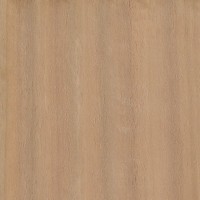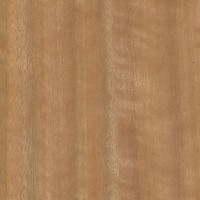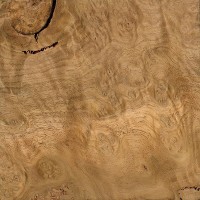 |
Common Name(s): Mountain Ash, Victorian Ash Scientific Name: Eucalyptus regnans Distribution: Southeastern Australia, also grown on plantations Tree Size: 230-330 ft (70-100 m) tall, 3-5 ft (1-1.5 m) trunk diameter Average Dried Weight: 42 lbs/ft3 (680 kg/m3) Specific Gravity (Basic, 12% MC): .49, .68 Janka Hardness: 1,210 lbf (5,400 N) Modulus of Rupture: 14,010 lbf/in2 (96.7 MPa) Elastic Modulus: 2,033,000 lbf/in2 (14.02 GPa) Crushing Strength: 8,530 lbf/in2 (58.8 MPa) Shrinkage: Radial: 6.5%, Tangential: 13.0%, Volumetric: 19.6%, T/R Ratio: 2.0 |
Color/Appearance: Heartwood tends to be a medium yellow to light brown. Sapwood slightly slighter than heartwood, but not clearly demarcated. Gum and mineral veins and streaks are common in the heartwood.
Grain/Texture: Grain is straight, with a medium to coarse texture.
Rot Resistance: Rated as very durable regarding decay resistance, with moderate insect resistance.
Workability: Overall easy to work with hand and machine tools. Glues, turns, and finishes well.
Odor: No characteristic odor.
Allergies/Toxicity: Although severe reactions are quite uncommon, Mountain Ash has been reported to cause eye, skin, and respiratory irritation. See the articles Wood Allergies and Toxicity and Wood Dust Safety for more information.
Pricing/Availability: Not commonly imported to the United States, Mountain Ash is more widely used and available in Australia and New Zealand. Turned blocks and burls are sometimes available in the United States, with prices in the mid range for an imported species.
Sustainability: This wood species is not listed in the CITES Appendices or on the IUCN Red List of Threatened Species. However, though Mountain Ash as a species is not threatened, there’s controversy surrounding its harvesting in Australia because its forests provide habitat for other birds and mammals, some of which are endangered or threatened.
Common Uses: Veneer, plywood, boatbuilding, general construction/utility wood, flooring, and turned objects.
Comments: Among the most massive of trees in the entire world, Mountain Ash specimens hold ranks in the top ten largest trees for total height, girth, and total volume.
Mountain Ash is not a true ash (Fraxinus genus) but is instead in the unrelated Eucalyptus genus.
- Blue Gum (Eucalyptus globulus)
- Brown Mallee (Eucalyptus dumosa)
- Coolibah (Eucalyptus coolabah)
- Deglupta (Eucalyptus deglupta)
- Jarrah (Eucalyptus marginata)
- Karri (Eucalyptus diversicolor)
- Lyptus® (Eucalyptus urograndis)
- Messmate (Eucalyptus obliqua)
- Red Mallee (Eucalyptus oleosa)
- River Red Gum (Eucalyptus camaldulensis)
- Rose Gum (Eucalyptus grandis)
- Swamp Mahogany (Eucalyptus robusta)
- White Box (Eucalyptus hemiphloia)
- Yellow Box (Eucalyptus melliodora)
- Yellow Gum (Eucalyptus leucoxylon)
None available.
Scans/Pictures: A special thanks to Steve Earis for providing the wood sample (veneer) of this wood species.
 |
 |
 |


Hi,
we would like to know, why Victorian ash is not widely used for furniture?
thanks
It was fairly common to find Tassie Oak furniture in the 2000s along with a number of other native species, but locally made furniture is difficult to find these days in favour of imported furniture (both cheap and expensive). It is a beautiful looking: very light-coloured and tending to a warm cream in a raw state. It can however but can be easily dented with direct blows from dropped objects and the like. I have Tassie Oak floors in my kitchen and every dropped object has left a dent.
What’s confusing even to Australians is these European names are not just incorrect but also interchangeable. Tasmanian oak for example is called Victorian Ash when it comes from Victoria instead of Tasmania. What’s even more confusing is that the ‘Tasmanian Oak’ you buy at hardware stores is actually the Tasmanian timber industry’s name for timber that comes from three different species of eucalypt, harvested in three different regions of the state. From Wikipedia: “Tasmanian oak[1] refers to the hardwood produced by three trees: Eucalyptus regnans, Eucalyptus obliqua or Eucalyptus delegatensis, when it is sourced from the Australian state of Tasmania.[2] Despite the common name ‘oak’, none of the species are in… Read more »
Yes, like America and most other ‘settled by European colonisation’ counties, many places and things in Australia are named after places and things from ‘back home’. We have pine trees that aren’t pines, mahoganies that aren’t mahoganies and so on. (Magpies, that while corvids, aren’t the same as European Magpies. But they are black and white.) Similar looking things, often got named after things from the home country.
Australian Magpies are not corvids, though they look similar.
Europeans came to Australia and named things. Don’t get upset about common names, they don’t mean much. We also call this species Tasmanian Oak – hope this helps ;)
I am very confused by this entry. To me “mountain ash” ARE Rowan but are not “Eucalyptus”, they are “Sorbus” of the family “Rosaceae” and have been for hundreds if not thousands of years. How did an Australian tree supplant names that have been in use in Europe going back at least to the ancient Celts?
Australia has 800 species of eucalypt and 1000 species of acacia, so when dealing with Aussie hardwoods, there is a fighting chance it will be one or the other, whether Tasmanian Oak, Curly Budgeroo, Ironbark, or Ringed Gidgee :) Yes we have many other interesting species too, many of which are not eucalypts but are related in the family myrtaceae. I’m still finding woods which are not commercially available but have local distribution and unique beauty and usefulness. When europeans came here they dubbed various species as oak, ash, cedar, and so on; but this was usually based on superficial… Read more »